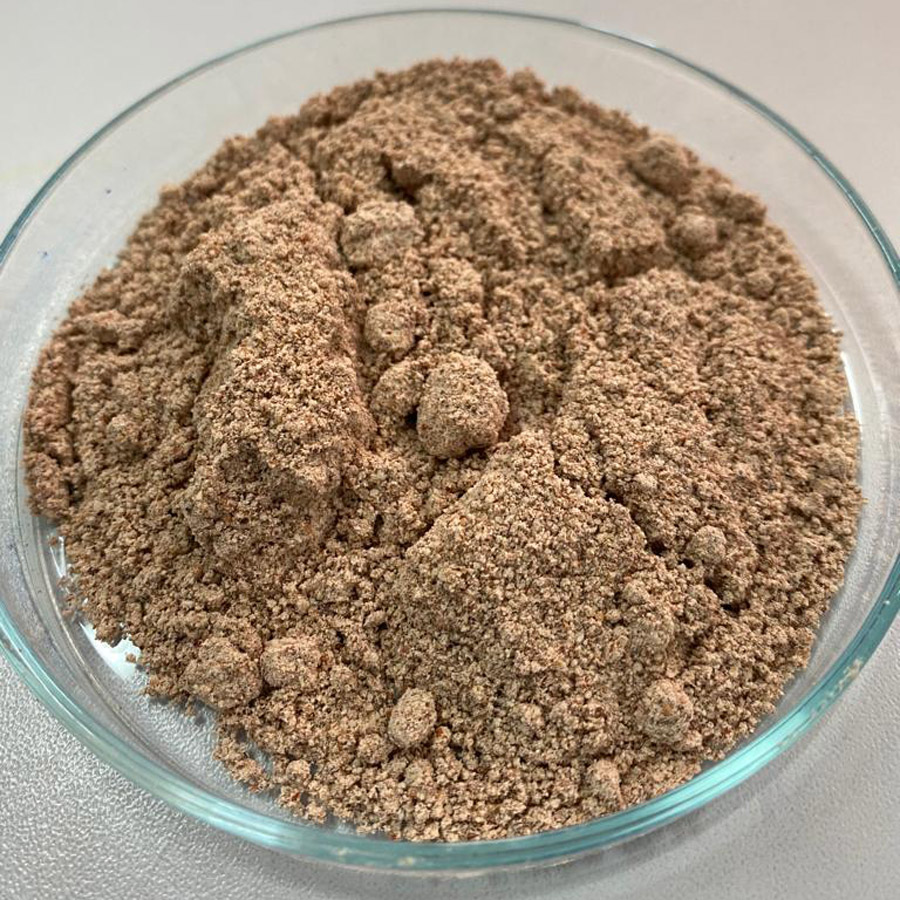Flour made with sorghum BRS 305, developed by Embrapa, generated reduction of hepatic steatosis (fat accumulation in the liver) in laboratory animals. The product also improved glucose metabolism. The research was conducted in a partnership between Embrapa and the Federal University of Viçosa The study also recorded a reduction in fat formation (lipogenesis), triglycerides formation and uric acid formation in the animals after they consumed the flour.. Flour consumption increased insulin sensitivity and glucose tolerance. The animals who consumed the flour also had lower liver inflammation and lower blood plasma inflammation. Hybrid sorghum BRS 305, by Embrapa, was identified among hundreds of genotypes as a superior material in these functional activities, which was also proven in other studies Research by Embrapa and the Federal University of Viçosa (UFV) showed that whole flour made with sorghum BRS 305, a cultivar developed by Embrapa, reduced fat accumulation in the liver in rats, a medical condition known as hepatic steatosis. Scientists have also recorded several other effects caused by the flour, such as helping to control excess fat in the body (adiposity) and reducing triglycerides and uric acid. Sorghum has also improved insulin sensibility and glucose tolerance. The animals that were analyzed had received a high-fat and high-fructose (HFHF) diet. The result of this research integrates Oscar David Medina Martinez's (on the right in the photo) doctoral thesis and was published in the Journal of Cereal Science, in the paper Dry heated whole sorghum flour (BRS 305) with high tannin and resistant starch improves glucose metabolism, modulates adiposity, and reduces liver steatosis and lipogenesis in Wistar rats fed with a high-fat high-fructose diet. "We observed that the metabolic changes caused by the HFHF diet were reversed by the sorghum BRS 305 flour, replacing 50% of the daily fiber recommendation, for ten weeks", says professor Hercia Stampini Duarte Martino, from UFV's Department of Nutrition and Health. In addition to these benefits, less accumulation and higher breakdown of body fat were registered in the animals, and even less inflammation and oxidative stress in the liver and blood plasma. The goal of this study was to check the effect of the sorghum BRS 305 flour in the treatment of metabolic changes caused by a HFHF diet in Wistar rats. According to Martino, the study shows that sorghum has potential to contribute to reversing the damage to the body caused by the HFHF diet, which is a typical Western diet nowadays. Researcher Valéria Queiroz, from Embrapa Maize and Sorghum,points out that these results are related to the high concentration of tannins and resistant starch, to the profile of phenolic compounds and to the high antioxidant capacity present in this sorghum hybrid. She says that, for over decade, Embrapa has been developing research aimed at adding nutritional and functional value to sorghum grains for use in human food. The hybrid BRS 305 was selected among hundreds of analyzed genotypes as a superior material in these characteristics of interest, and its functional potential has been proven by other studies like the present one (read box below). “The improvement in glucose metabolism, associated with the reduction of inflammation, oxidative stress and excess body fat, provoked by sorghum consumption, is vital for reducing the risk of developing chronic diseases, such as diabetes mellitus, cancer, cardiovascular diseases, among others. Therefore, sorghum, as it is low-cost and has excellent nutritional composition, can contribute directly to the health and quality of life of the population", Hércia Martino adds. A sorghum developed for human consumption BRS 305 (pictured on the left) is a hybrid of graniferous sorghum, developed by Embrapa in the 1990s, for use in cattle feeding. Researcher Valéria Queiroz explains that, in 2010, Embrapa Maize & Sorghum, in partnership with several universities, began a line of research whose goal was to value and disseminate the use of sorghum as human food in Brazil. "Hundreds of sorghum genotypes, including lines, varieties and hybrids, were analyzed for composition in bioactive substances. Among these, the BRS 305 hybrid stood out with high levels of total phenolic compounds, tannins and resistant starch and high antioxidant capacity; therefore, it has high potential for use in the production of food with claims of functional properties, that is, that can bring health benefits", Queiroz said. Among the results obtained, a study in partnership with UFV's Department of Nutrition and Health showed that the BRS 305 genotype contained an eight-times-higher concentration of total phenolics and a 21-times-higher concentration of tannins in relation to sorghum BRS 309, and seven-times-higher levels of total phenolics and five-times-higher levels of tannins in relation to sorghum BRS 310 (check article). Furthermore, according to Cícero Beserra de Menezes, sorghum breeder at Embrapa, this hybrid also presented interesting agronomic traits, since, among 12 materials analyzed under water deficiency, sorghum BRS 305 was one of the two most productive ones. The research data were published here.
Photo: Cícero Menezes

Study shows that sorghum has the potential to revert harm caused by diets that are rich in saturated fats and fructose
Research by Embrapa and the Federal University of Viçosa (UFV) showed that whole flour made with sorghum BRS 305, a cultivar developed by Embrapa, reduced fat accumulation in the liver in rats, a medical condition known as hepatic steatosis. Scientists have also recorded several other effects caused by the flour, such as helping to control excess fat in the body (adiposity) and reducing triglycerides and uric acid. Sorghum has also improved insulin sensibility and glucose tolerance. The animals that were analyzed had received a high-fat and high-fructose (HFHF) diet.
 The result of this research integrates Oscar David Medina Martinez's (on the right in the photo) doctoral thesis and was published in the Journal of Cereal Science, in the paper Dry heated whole sorghum flour (BRS 305) with high tannin and resistant starch improves glucose metabolism, modulates adiposity, and reduces liver steatosis and lipogenesis in Wistar rats fed with a high-fat high-fructose diet.
The result of this research integrates Oscar David Medina Martinez's (on the right in the photo) doctoral thesis and was published in the Journal of Cereal Science, in the paper Dry heated whole sorghum flour (BRS 305) with high tannin and resistant starch improves glucose metabolism, modulates adiposity, and reduces liver steatosis and lipogenesis in Wistar rats fed with a high-fat high-fructose diet.
"We observed that the metabolic changes caused by the HFHF diet were reversed by the sorghum BRS 305 flour, replacing 50% of the daily fiber recommendation, for ten weeks", says professor Hercia Stampini Duarte Martino, from UFV's Department of Nutrition and Health. In addition to these benefits, less accumulation and higher breakdown of body fat were registered in the animals, and even less inflammation and oxidative stress in the liver and blood plasma. The goal of this study was to check the effect of the sorghum BRS 305 flour in the treatment of metabolic changes caused by a HFHF diet in Wistar rats.
According to Martino, the study shows that sorghum has potential to contribute to reversing the damage to the body caused by the HFHF diet, which is a typical Western diet nowadays.
Researcher Valéria Queiroz, from Embrapa Maize and Sorghum,points out that these results are related to the high concentration of tannins and resistant starch, to the profile of phenolic compounds and to the high antioxidant capacity present in this sorghum hybrid.

She says that, for over decade, Embrapa has been developing research aimed at adding nutritional and functional value to sorghum grains for use in human food. The hybrid BRS 305 was selected among hundreds of analyzed genotypes as a superior material in these characteristics of interest, and its functional potential has been proven by other studies like the present one (read box below).
“The improvement in glucose metabolism, associated with the reduction of inflammation, oxidative stress and excess body fat, provoked by sorghum consumption, is vital for reducing the risk of developing chronic diseases, such as diabetes mellitus, cancer, cardiovascular diseases, among others. Therefore, sorghum, as it is low-cost and has excellent nutritional composition, can contribute directly to the health and quality of life of the population", Hércia Martino adds.
 A sorghum developed for human consumption A sorghum developed for human consumption
BRS 305 (pictured on the left) is a hybrid of graniferous sorghum, developed by Embrapa in the 1990s, for use in cattle feeding. Researcher Valéria Queiroz explains that, in 2010, Embrapa Maize & Sorghum, in partnership with several universities, began a line of research whose goal was to value and disseminate the use of sorghum as human food in Brazil. "Hundreds of sorghum genotypes, including lines, varieties and hybrids, were analyzed for composition in bioactive substances. Among these, the BRS 305 hybrid stood out with high levels of total phenolic compounds, tannins and resistant starch and high antioxidant capacity; therefore, it has high potential for use in the production of food with claims of functional properties, that is, that can bring health benefits", Queiroz said. Among the results obtained, a study in partnership with UFV's Department of Nutrition and Health showed that the BRS 305 genotype contained an eight-times-higher concentration of total phenolics and a 21-times-higher concentration of tannins in relation to sorghum BRS 309, and seven-times-higher levels of total phenolics and five-times-higher levels of tannins in relation to sorghum BRS 310 (check article). Furthermore, according to Cícero Beserra de Menezes, sorghum breeder at Embrapa, this hybrid also presented interesting agronomic traits, since, among 12 materials analyzed under water deficiency, sorghum BRS 305 was one of the two most productive ones. The research data were published here. |
Sandra Brito (MTb 6.230/MG)
Embrapa Maize and Sorghum
Press inquiries
milho-e-sorgo.imprensa@embrapa.br
Phone number: +55 31 3027-1223
Translation: Alessandra Marin, supervised by Mariana Medeiros (13044/DF)
Superintendecy of Communications
Further information on the topic
Citizen Attention Service (SAC)
www.embrapa.br/contact-us/sac/

 The result of this research integrates Oscar David Medina Martinez's (on the right in the photo) doctoral thesis and was published in the Journal of Cereal Science, in the paper Dry heated whole sorghum flour (BRS 305) with high tannin and resistant starch improves glucose metabolism, modulates adiposity, and reduces liver steatosis and lipogenesis in Wistar rats fed with a high-fat high-fructose diet.
The result of this research integrates Oscar David Medina Martinez's (on the right in the photo) doctoral thesis and was published in the Journal of Cereal Science, in the paper Dry heated whole sorghum flour (BRS 305) with high tannin and resistant starch improves glucose metabolism, modulates adiposity, and reduces liver steatosis and lipogenesis in Wistar rats fed with a high-fat high-fructose diet.

